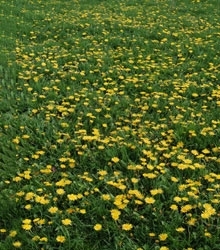Dandelions
 Dandelions burst into flower in the month of April. So why is it called a dandelion? In mediaeval Latin it was called “dens leonis” and still in France it is known as “dent de lion” most probably due to the jagged shape of the leaves or perhaps because the long white tap root resembles a lion’s tooth.
Dandelions burst into flower in the month of April. So why is it called a dandelion? In mediaeval Latin it was called “dens leonis” and still in France it is known as “dent de lion” most probably due to the jagged shape of the leaves or perhaps because the long white tap root resembles a lion’s tooth.
Because the dandelion is one of the first widespread flowers of the year, it is very important to many insects which need to gather pollen and nectar and you can often see bees along with small tortoiseshell butterflies feeding eagerly on the opened yellow flowers. Before too long the flowers will close, re-opening as large gossamer balls of plumed seed known as “clocks”, ready to be blown away on the wind.
There are many country names given to the plant at this stage of its life due to the tradition of children blowing the seed heads off, either to tell the time by the number of puffs it takes to clear the plant of its seeds, or to find out if a girl or boy friend is true. Clock flower, fairy clocks, shepherd’s clock and love clock are just a few. Two other intriguing names are priest’s crown and wet-the-bed! The first relates to the empty disc that held the seeds, now a bare round white crown not dissimilar to a shaven head – a practice that most clergy followed in the Middle Ages. The second name leads us to the medicinal properties of the plant, as it is a diuretic and laxative and was also commonly used for biliousness, kidney and liver disorders.
Dandelions were not only used for medicinal purposes but were also widely eaten in one form or other. Dandelion leaves were collected for making wine, a wonderfully descriptive account of which occurs in Laurie Lee’s Cider with Rosie, and beer, tea and even coffee was made by roasting and grounding up the roots. The young leaves are very tasty in salads (older leaves are rather bitter) and anyone who has kept a pet rabbit or guinea pig will know that they are firm favourites. The seeds are also keenly sought after by birds such as linnet, greenfinch and goldfinch as they are among the first new seeds of the year to be produced.
Peter Thompson
Advisory

Download Peter Thompson's essential 26-page book, featuring beautiful photography and detailed profiles of Britain's wildlife
Download FREE >